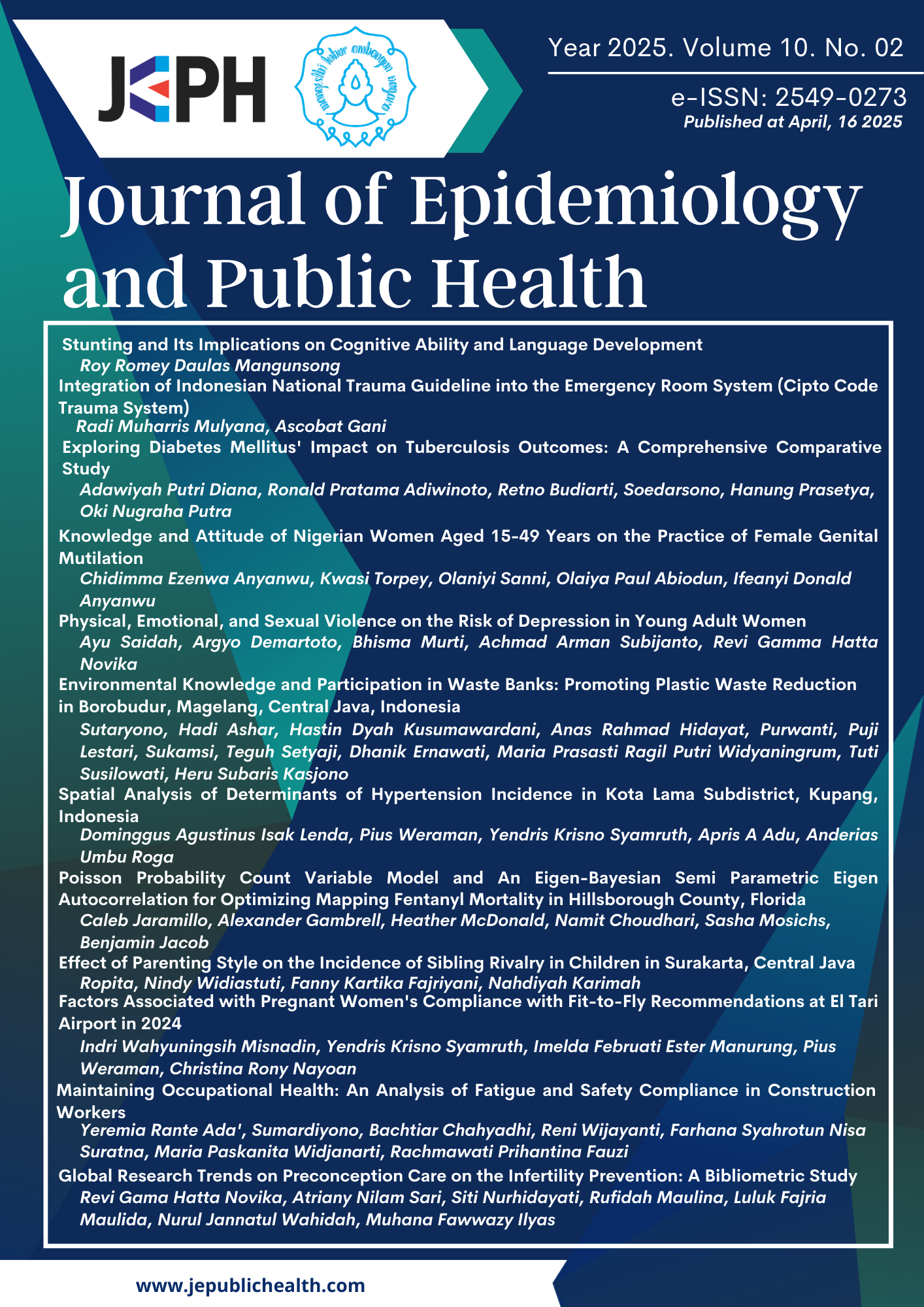Maintaining Occupational Health: An Analysis of Fatigue and Safety Compliance in Construction Workers
DOI:
https://doi.org/10.26911/jepublichealth.2025.10.02.11Abstract
Background: Safety compliance is a critical component in preventing workplace accidents and ensuring employee well-being. Various factors may influence workers’ adherence to safety protocols, including individual characteristics such as education level and fatigue. The purpose of this study was to examine the relationships between education level, work fatigue, and safety compliance.
Subjects and Method: This cross-sectional study involved 137 respondents, categorized by fatigue status. The dependent variable was safety compliance. Independent variables included work fatigue and education level. Instruments included the Fatigue Assessment Scale (FAS) questionnaire for fatigue. Data analysis utilized the chi-square test for fatigue and education levels.
Results: The proportion of workers who comply with safety procedures varies across education levels, but the differences are not statistically significant. In contrast, workers with higher levels of fatigue were significantly more compliant with safety practices than those with lower fatigue..
Conclusion: These findings highlight the complexity of behavioral responses to workplace demands and the need for targeted interventions.
Keywords:
Occupational health and safety, fatigue, compliance, constructionReferences
Acheampong A, Adjei EK, Adade-Boateng A, Acheamfour VK, Afful AE, Boateng E (2024). Impact of construction workers informal safety communication (CWISC) on safety performance on construction sites. Eng Constr Archit Manag. doi: 10.1108/ECAM-09-2023-0906.
Aka A, Bello AO, Bamgbade AA, Bilau AA (2024). Age-performance consideration in the recruitment of tradespeople in Nigerian construction industry. Eng Constr Archit Manag. 31:386–404. doi: 10.1108/ECAM-05-2022-0430.
Alkhaledi KA, Bendak S, Dashti FA (2023). Assessing safety culture in public sector organisations: A cross-national study. Int J Ind Ergon. 94:103425. doi: 10.1016/j.ergon.2023.103425.
Alroomi AS, Mohamed S (2022). Does fatigue mediate the relation between physical isolation and safety behaviour among isolated oil and gas workers? Saf Sci. 147:105639. doi:10.1016/j.ssci.2021.105639.
Andersen LPS, Grytnes R (2021). Different ways of perceiving risk and safety on construction sites and implications for safety cooperation. Constr Manag Econ. 39:419–431. doi:10.1080/0144-6193.2021.1904516.
Aulia A, Tjendera M (2018). Hubungan kelelahan kerja dengan kejadian kecelakaan kerja pada pekerja galangan kapal. J Kesmas Gizi.
Ayu BF, Tualeka AR, Wahyudiono YDA (2018). The analysis of factors which are related to the compliance of welder workers in using workplace personal protective equipment in Pt. Pal Indonesia. Indian J Public Health Res Dev. 9:47–52. doi:10.5958/0976-5506.2018.00410.2.
Baidwan NK, Gerberich SG, Kim H, Ryan AD, Church TR, Capistrant B (2018). A longitudinal study of work-related injuries: comparisons of health and work-related consequences between injured and uninjured aging United States adults. Inj Epidemiol. 5:7. doi: 10.1186/s40621-018-0166-7.
Bushuven S, Bansbach J, Bentele M, Trifunovic-Koenig M, Bentele S, Gerber B, hagen F, et al. (2023). Overconfidence effects and learning motivation, refreshing BLS: An obser-vational questionnaire study. Resusc Plus. 14:100369. doi:10.1016/j.resplu.2023.100369.
Chan APC, Guan J, Choi TNY, Yang Y (2023). Moderating Effects of Indivi-dual Learning Ability and Resilient Safety Culture on the Relationship between the Educational Level and Safety Performance of Construction Workers. Buildings. 13. doi: 10.3390/buildings13123026.
Cheng L, Ren H, Guo H, Cao D (2024). Research on the evaluation method for safety cognitive ability of workers in high-risk construction positions. Eng Constr Archit Manag. doi: 10.1108/ECAM-05-2024-0625.
Çınar S (2020). Construction labour, sub-contracting and masculinity: "construction is a man's job." Constr Manag Econ. 38:275–290. doi:10.1080/01446193.2019.1690155.
Curtis SJ, Trewin A, McCormack LM, Were K, McDermott K, Walsh N (2023). Building a safety culture for infection prevention and control adherence at Howard Springs: A workplace survey. Infect Dis Health. 28:47–53. doi: 10.1016/j.idh.2022.07.004
Delloiacono N (2016). Origin of a musculoskeletal guideline: Caring for older workers. Work Health Saf. 64:262–268. doi:10.1177/2165079915623964.
Deng S, Peng R, Pan Y (2022). A cognitive failure model of construction workers’ unsafe behavior. Adv Civ Eng. 2022: 2576600. doi:10.1155/2022/2576600.
Di-Giampaolo L, Marino FC, Giurgola C, Astolfi P, Coppeta L, De Sio S, Borrelli P, et al. (2024). Mitigating overconfidence bias: A cross-sectional pilot study of male maintenance workers in the engineering sector. J Health Soc Sci. 9:551–563.doi:10.19204/2024/MTGT7.
Dzeng RJ, Lin CT, Fang YC. (2016). Using eye-tracker to compare search patterns between experienced and novice workers for site hazard identification. Saf Sci. 82:56–67. doi:10.1016/j.ssci.2015.08.008.
Emuze F (2020). Factors causing fatigue and safety-related errors on construction sites in Bloemfontein. ARCOM 2020 - Assoc Res Constr Manag 36th Annu Conf. 215–224.
Fang D, Jiang Z, Zhang M, Wang H (2015). An experimental method to study the effect of fatigue on construction workers’ safety performance. Saf Sci. 73: 80–91. doi:10.1016/j.ssci.2014.11.019.
Farhadi F, Davoodi SM, MN (2020). Presenting the model of safety-conscious work environment in the gas relationship to visual fatigue company of Chaharmahal and Bakhtiari province. Iran Occup Health. 17:823–835.
Fitri RY, Sukesi TW, Hariyono W (2024). Factors contributing to work fatigue among construction workers. Arter J Ilmu Kesehat. 5:18–25. doi:10.37148/arteri.v5i1.395.
Gultekin D, Hisarciklilar M, Yusufi F (2024). Multiple faces of labour market segmentation within the Turkish construction industry. Econ Labour Relat Rev. 1–22. doi:10.1017/elr.2024.35.
Haas EJ, Eiter B, Hoebbel C, Ryan ME (2019). The impact of job, site, and industry experience on worker health and safety. Safety 5. doi: 10.3390/safety5010016.
Han Y, Jin R, Wood H, Yang T (2019). Investigation of demographic factors in construction employees’ safety perceptions. KSCE J Civ Eng. 23:2815–2828. doi:10.1007/s12205-019-2044-4.
Hashiguchi N, Sengoku S, Kubota Y, Kitahara S, Lim Y, Kodama K (2021). Age-dependent influence of intrinsic and extrinsic motivations on construction worker performance. Int J Environ Res Public Health. 18:10111. doi:10.3390/ijerph18010111.
Heng PP, Yusoff HM, Hod R (2024). Individual evaluation of fatigue at work to enhance the safety perform-ance in the construction industry: A systematic review. PLoS One. 19: e0287892.doi:10.1371/journal.pone.0287892.
Hinss MF, Brock AM, Roy RN (2022). Cognitive effects of prolonged continuous human-machine interaction: The case for mental state-based adaptive interfaces. Front Neuroergon. 3: 935092. doi: 10.3389/fnrgo.2022.935092.
Idrees MD, Hafeez M, Kim JY (2017). Workers’ age and the impact of psychological factors on the perception of safety at construction sites. Sustainability. 9: 745. doi:10.3390/su9050745.
Idrisova JI, Myasnikov VN, Uljanov AI, Belina NV (2018). Increasing the efficiency of labor protection in the enterprise. Int Conf Inf Netw. 2018-Janua : 586–588. doi: 10.1109/ICOIN.2018.8343186
Jaladara V, Hasanbasri M (2024). Beyond the surface: A perspective on the psychosocial dimensions in mining operations in Indonesia. BIO Web Conf. 132:04001. doi:10.1051/bioconf/202413204001.
Kao KY, Spitzmueller C, Cigularov K, Thomas CL (2019). Linking safety knowledge to safety behaviours: A moderated mediation of supervisor and worker safety attitudes. Eur J Work Organ Psychol. 28:206–220. doi:10.1080/1359432X.2019.1567492.
Khodabandeh F, Kabir-Mokamelkhah E, Kahani M (2016). Factors associated with the severity of fatal accidents in construction workers. Med J Islam Repub Iran. 30:1–7.
Kim S, Kim JK (2017). Road safety for an aged society: Compliance with traffic regulations, knowledge about traffic regulations, and risk factors of older drivers. Transp Res Rec. 2660 : 15–21. doi: 10.3141/266003.
Lu L, Luo T, Zhang Y (2023). Perceived overqualification and deviant innovation behavior: The roles of creative self-efficacy and perceived organizational support. Front Psychol. 14:1–8. doi: 10.3389/fpsyg.2023.967052.
Morgan J, Reidy J, Probst T (2019). Age group differences in household accident risk perceptions and intentions to reduce hazards. Int. J. Environ. Res. Public Health 16 : 1–19. doi: 10.3390/ijerph16122237.
Neale J, Gurmu A (2022). Production pressures in the building sector of the construction industry: a systematic review of literature. J Eng Des Tech-nol. 20: 1412–1429.doi:10.1108/JEDT-12-2020-0529.
Oranye NO, Wallis B, Roer K, Archer-Heese G, Aguilar Z (2016). Do personal factors or types of physical tasks pre-dict workplace injury? Work Health Saf. 64:141–151. doi: 10.1177/2165079916630552.
Ouyang Y, Luo X (2025). Effects of physical fatigue superimposed on high tempe-ratures on construction workers’ cog-nitive performance. Saf Sci. 181. doi: 10.1016/j.ssci.2024.106705.
Patrisia Y (2018). Pengaruh beban kerja, kelelahan kerja terhadap kesehatan dan keselamatan kerja (K3). Psikoborneo J Ilm Psikol. 6:142–149. doi: 10.30872/psikoborneo.v6i1.4538.
Peng L, Chan A (2019). Exerting Explanatory Accounts of Safety Behavior of Older Construction Workers within the Theory of Planned Behavior. Int. J. Environ. Res. Public Health 16. doi: 10.3390/ijerph16183342.
Putri SS, Wahyuningsih AS (2024). Risk factors of unsafe behavior among construction workers. J Presipitasi Media Komun Pengemb Tek Lingkung. 21: 41–50. doi:10.14710/presipitasi.v21i1.4150.
Redfern N, Bilotta F, Abramovich I, Grigoras I (2023). Fatigue in anaesthesiology: Call for a change of culture and regulations. Eur J Anaesthesiol. 40:78–81. doi:10.1097/EJA.0000000000001767.
Rembiasz M (2017). Impact of employee age on the safe performance of production tasks. MATEC Web Conf. 94. doi: 10.1051/matecconf/20179407009.
Rosi A, van-Vugt FT, Lecce S, Ceccato I, Vallarino M, Rapisarda F, Vecchi T et al. (2021). Risk Perception in a Real-World Situation (COVID-19): How It Changes From 18 to 87 Years Old. Front Psychol. 12: 1–8. doi: 10.3389/fpsyg.2021.646558.
Rules S (2023). Hubungan latihan keselamatan, peraturan dan prosedur keselamatan terhadap prestasi keselamatan anggota kerja. GIATMARA. 6:1-9.
Sokas RK, Dong XS, Cain CT (2019). Building a sustainable construction workforce. Int J Environ Res Public Health. 16. doi: 10.3390/ijerph16214202.
Soltanzadeh A, Heidari H, Mahdinia M, Mohammadi H, Mohammadbeigi A, Mohammadfam I (2019). Path analysis of occupational injuries based on the structural equation modeling approach: A retrospective study in the construction industry. Iran Occup Heal. 16:47–57.
Taherpour F, Ghiasvand E, Namian M (2021). The effect of fatigue on safety attitude, hazard recognition and safety risk perception among construction workers. Amirkabir J Civ Eng. 53:8–8. doi: 10.22060/ceej.2020.17830.6688.
Wahyuningtyas M, Ariyani N, Sugiharto S (2023). Pengaruh kesadaran dan pe-ngawasan terhadap kepatuhan pelaksanaan SMK3 pada pekerja konstruksi di PT X Kabupaten Pacitan. Malahayati Nurs J. 5:2638–2654. doi: 10.33024/mnj.v5i8.10633.
Wang W, Xie J, Hou X, Song M, Zheng K (2019). Safety training education system and method and business model. PubGenius Inc.
Wang X, Wang X, Huang Y (2019). Chinese construction worker reluctance toward vocational skill training. J Eng Des Technol. 17:155–171. doi: 10.1108/JEDT-06-2018-0100.
Wang X, Wang Y, Su JH, Liu L, Jin Y, He C, Wang Y, et al. (2024). Health Risks and Improvement Measures of Construction Site Environment for Aging Construction Workers in China. Int Rev Spat Plan Sustain Dev. 12:98–116. doi: 10.14246/IRSPSD.12.4_98
Xia N, Xie Q, Hu X, Wang X, Meng H (2020). A dual perspective on risk perception and its effect on safety behavior: A moderated mediation model of safety motivation, and supervisor’s and coworkers’ safety climate. Accid Anal Prev. 134 : 105350. doi: 10.1016/j.aap.2019.105350.
Yuan M, Tang T, Zhao S, Xue X, Luo B (2024). The Factors Influencing Safety Compliance Behavior Among New-Generation Construction Workers in China: A Safety Compliance Behavior–Artificial Neural Network Model Approach. Buildings. 14. doi: 10.3390/buildings14123774.
Zhang M, Murphy LA, Fang D, Caban-Martinez AJ (2015). Influence of fatigue on construction workers’ physical and cognitive function. Occup Med (Chic Ill). 65 : 245–250. doi: 10.1093/occmed/kqu215.
Zhang Z, Xiang T, Guo H, Ma L, Guan Z, Fang Y (2023). Impact of physical and mental fatigue on construction workers’ unsafe behavior based on physiological measurement. J Safety Res. 85: 457–468.doi:10.1016/j.jsr.2023.04.014.
Zong H, Yi W, Antwi-Afari MF, Yu Y (2024). Fatigue in construction workers: A systematic review of causes, evaluation methods, and interventions. Saf Sci. 176: 106529. doi: 10.1016/j.ssci.2024.106529.




1.jpg)








